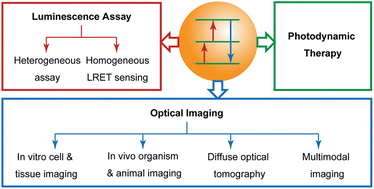Upconversion nanoparticles in biological labeling, imaging, and therapy
Abstract
Upconversion refers to non-linear optical processes that convert two or more low-energy

* Corresponding authors
a
Department of Chemistry, Faculty of Science, National University of Singapore, 3 Science Drive 3, Singapore
E-mail:
chmlx@nus.edu.sg
b Advanced Materials for Micro- and Nano-Systems Program, Singapore–MIT Alliance, Singapore
c Key Laboratory of Optoelectronic Materials Chemistry and Physics, Fujian Institute of Research on the Structure of Matter, Chinese Academy of Sciences, Fuzhou, Fujian 350002, China
Upconversion refers to non-linear optical processes that convert two or more low-energy

 Please wait while we load your content...
Something went wrong. Try again?
Please wait while we load your content...
Something went wrong. Try again?
F. Wang, D. Banerjee, Y. Liu, X. Chen and X. Liu, Analyst, 2010, 135, 1839 DOI: 10.1039/C0AN00144A
To request permission to reproduce material from this article, please go to the Copyright Clearance Center request page.
If you are an author contributing to an RSC publication, you do not need to request permission provided correct acknowledgement is given.
If you are the author of this article, you do not need to request permission to reproduce figures and diagrams provided correct acknowledgement is given. If you want to reproduce the whole article in a third-party publication (excluding your thesis/dissertation for which permission is not required) please go to the Copyright Clearance Center request page.
Read more about how to correctly acknowledge RSC content.
 Fetching data from CrossRef.
Fetching data from CrossRef.
This may take some time to load.
Loading related content
